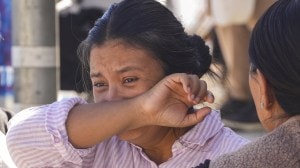Begin with a reconsideration of the LoC
The statement last month of the former Pakistan Army chief, General Aslam Beg, on the Pakistani troops having entered parts of Jammu and Kas...

The statement last month of the former Pakistan Army chief, General Aslam Beg, on the Pakistani troops having entered parts of Jammu and Kashmir in 1990-91 underlines a pattern which is commonplace in that region.
Pak troops had occupied one of the gullies (openings) in the higher reaches of Kupwara area of J&K after these were abandoned by Indian troops in the winter months, which is a common practice. When this intrusion was discovered, a battalion holding the area was launched to clear it.
During that time an even more serious flare-up occurred in the Poonch-Rajouri area of J&K. Following reports that Pakistan was using this area for infiltration of terrorists, steps were taken to curb this. A small posse of the Pak army, which enjoyed a domineering position, occupied Kirni village and took its inhabitants hostage. This was instantly cleared and in the ensuing clash, the Pakistan Army lost a young officer. When they launched a battalion assault to avenge this, it was beaten back with heavy artillery.Since the Indian troops had prepared for such an eventuality, Pakistan troops suffered heavily.
Perhaps no other border in this part of the world is so active. Minor skirmishes continue along the LoC the year around. Two and half years ago, when Pakistan objected to fencing, there was tension even along the international border near Jammu. Often in desperation, civilian areas have been targeted. Occasionally, even heavy artillery, anti-aircraft guns and anti-tank missiles are used, as in the Kupwara area three months ago. In Siachen, the battle of wits intensifies with the onset of winter, resulting in serious casualties. Occasionally, even helicopters and aircraft of the two sides have been fired upon and brought down by rival fire in Siachen.
Many of these skirmishes have been resolved only when the directors general of military operations of the two sides used the hot line to bring about a cease-fire. Herein lies a grave danger. A brash formation commander could escalate matters. Such a danger couldincrease further if and when tactical weapons with nuclear warheads are deployed in the region.
All this calls for certain confidence-building measures. In certain other trouble-spots in the world, a wide range of CBMs have been employed to lessen tensions, pacify borders and introduce a measured degree of transparency that does not impinge on the security of any participating state. While CBMs such as having demilitarised zones are not immediately possible in the Kashmir scenario, a small beginning could still be made.
For example, incidents of firing along the LoC are commonplace whenever there is a change of guard on either side. When a new battalion is inducted, it tries to gain ascendancy by oneupmanship, which usually includes incessant firing. If the two sides were to inform each other of change of formations along the LoC and enumerate on exact positions held on ground during the changeover, the number of such incidents may come down. Similarly, during winter months, when certain positions becomeinhospitable forcing troops to move down, the two sides could meet and agree on areas under their effective control. Even aerial inspections could be resorted to for checking the claim of both sides and "reaffirming" the LoC.
Of late, certain proposals such as a "no war pact" and "no first use" have emanated from the two sides. Since these are not easy decisions, they could take time. However, the two sides could easily agree not to fire on civilians settled along the border. As the Kashmir problem lingers, more and more villagers on both sides of the LoC have been forced to leave their homes. Of course, here the onus would lie mainly on Pakistan, since it has been taking help of civilians (in the form of guides and recruits to militant ranks) in its attempt to infiltrate terrorists into the area. Subsequent action by Indian troops has been mainly retaliatory in nature.
Some political leaders on both sides have been talking in terms of legitimising the LoC as the international border. This is unlikely togain acceptancy due to political uncertainty on both sides. However, in order to lessen tension, the two sides could start talking in terms of "readjusting" the LoC. This could be done on geographical lines, pending a final settlement. Of course, this would require a fair amount of give and take, particularly in the strategic areas such as the Chamb and Tangdhar sectors. For example, in the Valley, falling back to certain geographical lines (like the Pir Panjal range) would make it easier for the Indian troops to defend territory and also ward off infiltration.
Such a suggestion is bound to draw flak, for many would argue that it would amount to the two sides giving up their unequivocal stand on the Kashmir problem. But J&K problem is taking a heavy toll, particularly of the Indian Army. Compared to Pakistan, the Indian deployment in J&K is three times; this includes troops deployed deep inside the Valley and the Doda area to ward off terrorist attacks. A bilateral realignment of the border will enable usto lessen deployment not only along the LoC but also within the Valley for it will act as a checkmate to terrorism. Moreover, it does not go against the oft-repeated stance of the two sides. In fact it would be the first step towards a pragmatic solution to the final settlement – whether it is maintaining status quo or legitimising the LoC.





- 01
- 02
- 03
- 04
- 05


























